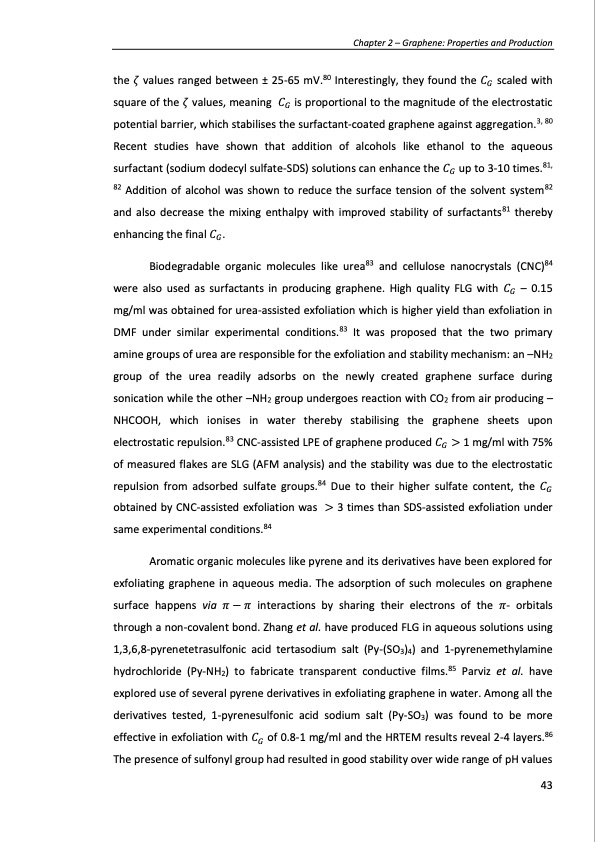PDF Publication Title:
Text from PDF Page: 043
the 𝜁 values ranged between ± 25-65 mV.80 Interestingly, they found the 𝐶𝐺 scaled with square of the 𝜁 values, meaning 𝐶𝐺 is proportional to the magnitude of the electrostatic potential barrier, which stabilises the surfactant-coated graphene against aggregation.3, 80 Recent studies have shown that addition of alcohols like ethanol to the aqueous surfactant (sodium dodecyl sulfate-SDS) solutions can enhance the 𝐶𝐺 up to 3-10 times.81, 82 Addition of alcohol was shown to reduce the surface tension of the solvent system82 and also decrease the mixing enthalpy with improved stability of surfactants81 thereby enhancing the final 𝐶𝐺. Biodegradable organic molecules like urea83 and cellulose nanocrystals (CNC)84 were also used as surfactants in producing graphene. High quality FLG with 𝐶𝐺 – 0.15 mg/ml was obtained for urea-assisted exfoliation which is higher yield than exfoliation in DMF under similar experimental conditions.83 It was proposed that the two primary amine groups of urea are responsible for the exfoliation and stability mechanism: an –NH2 group of the urea readily adsorbs on the newly created graphene surface during sonication while the other –NH2 group undergoes reaction with CO2 from air producing – NHCOOH, which ionises in water thereby stabilising the graphene sheets upon electrostatic repulsion.83 CNC-assisted LPE of graphene produced 𝐶𝐺 > 1 mg/ml with 75% of measured flakes are SLG (AFM analysis) and the stability was due to the electrostatic repulsion from adsorbed sulfate groups.84 Due to their higher sulfate content, the 𝐶𝐺 obtained by CNC-assisted exfoliation was > 3 times than SDS-assisted exfoliation under same experimental conditions.84 Aromatic organic molecules like pyrene and its derivatives have been explored for exfoliating graphene in aqueous media. The adsorption of such molecules on graphene surface happens via 𝜋 − 𝜋 interactions by sharing their electrons of the 𝜋- orbitals through a non-covalent bond. Zhang et al. have produced FLG in aqueous solutions using 1,3,6,8-pyrenetetrasulfonic acid tertasodium salt (Py-(SO3)4) and 1-pyrenemethylamine hydrochloride (Py-NH2) to fabricate transparent conductive films.85 Parviz et al. have explored use of several pyrene derivatives in exfoliating graphene in water. Among all the derivatives tested, 1-pyrenesulfonic acid sodium salt (Py-SO3) was found to be more effective in exfoliation with 𝐶𝐺 of 0.8-1 mg/ml and the HRTEM results reveal 2-4 layers.86 The presence of sulfonyl group had resulted in good stability over wide range of pH values Chapter 2 – Graphene: Properties and Production 43PDF Image | PRODUCTION AND APPLICATIONS OF GRAPHENE AND ITS COMPOSITES

PDF Search Title:
PRODUCTION AND APPLICATIONS OF GRAPHENE AND ITS COMPOSITESOriginal File Name Searched:
graphene-production-applications.PDFDIY PDF Search: Google It | Yahoo | Bing
Salgenx Redox Flow Battery Technology: Power up your energy storage game with Salgenx Salt Water Battery. With its advanced technology, the flow battery provides reliable, scalable, and sustainable energy storage for utility-scale projects. Upgrade to a Salgenx flow battery today and take control of your energy future.
CONTACT TEL: 608-238-6001 Email: greg@infinityturbine.com (Standard Web Page)